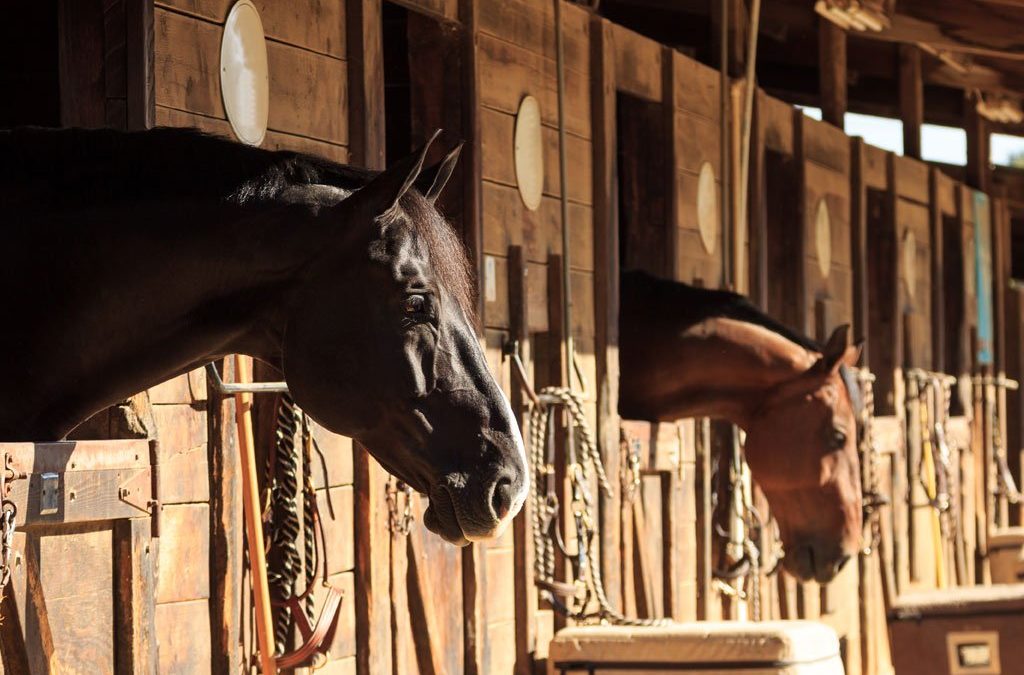Is Your Feeding Program up to Snuff?
When was the last time you evaluated what your horse is being fed? The nutritional needs of horses actually change quite frequently, and I always recommend a thorough evaluation of the forage, concentrate and supplements being fed to a horse every four months. Think about it, something has probably changed the nutritional requirements of almost every horse within the last four months. A mare was pregnant, now she is lactating. A horse is working hard showing in the summer whereas come winter he is turned out or given time off. A horse was racing and is now being trail ridden. A foal was nursing and is now weaned and must eat all on his own. All of these scenarios exemplify how as the daily routine of the horse changes, so must his feeding program. So, it’s time to ask yourself “Is my feeding program properly meeting the nutrient requirements of my horse?”
Several factors are involved in determining what and how much to feed a horse. Generally it is good to be able to identify age, weight and body condition, activity level, physiological and psychological conditions when putting together an individualized feeding program. Once all of these have been determined, the correct forage, concentrate and supplements can be selected. Let’s start with forage as this is always the most important portion of the equine diet. Horses cannot live with our fiber, but they can live without grain and supplements, so always try to maximize the use of pasture and forage that is available to your horse.
Since the basis of all diets for horses are forages, horses should always have ample amounts of the correct type of hay for their requirements available at all times. We used to preach feed the best “quality “ hay possible, but now we realize not all horses need high calorie, excellent quality hay. Certainly broodmares and foals, working horses and some geriatrics may need excellent quality forage, but others do better on lower quality so that they can consume more of the forage without gaining weight.
The horse by has evolved over millions of years as a grazer, with a digestive tract equipped to digest and utilize high levels of plant fiber. The cecum and colon, collectively known as the hind gut, house billions of microbes and protozoa that produce enzymes which breakdown or ferment plant fiber. These microbes are essential to the horse, since the horse itself does not produce these enzymes. The bi-products of microbial fermentation of forage provide the horse with a source of energy and micro-nutrients. A good forage choice for most horses is a grass and legume mixed hay. Horses with higher nutrient requirements can be fed more forages of higher quality such as alfalfa. Quality of hay is determined by the stage of maturity when cut, growing conditions, amount of fertilization of the field in which it is grown and how it is prepared and stored after being cut. Which cutting the hay is from is usually irrelevant as any cutting can turn out good or bad depending on these factors.
The science of equine nutrition has changed dramatically in the last 20 years as nutritionists have recognized the importance of feeding the horse a diet lower in refined sugars and starches. Gone are the days of the old cliché “feed hay, oats and water” as we now know this is not a balanced diet for the modern horse. Feeding less sugar and more fiber is much more natural for a horse, whose digestive tract and physiology is particularly inefficient at digesting, metabolizing and absorbing high levels of glucose, the end product of starch and sugar digestion. Some of the most profound improvements include the use concentrate rations containing higher fat and fiber fractions and the manufacturing of various combinations of feed ingredients that are then processed in various ways to stabilize and enhance the nutritional value of the product. Processed feeds, such as those that are cubed, pelleted, steamed, flaked, cracked, extruded (heated under pressure) or micronized (infra red waves heat and vibrate the starch molecule, restructuring or gelatinizing it), are a good choice for all horses because they are more easily digested and absorbed in the digestive tract. In addition, the starch in processed grains is much more readily absorbed pre-cecally than that found in ordinary sugary sweet grain mixes, vastly lowering the risk for colic, laminitis, tying up and other metabolic disorders related to fermentation of starch in the hind gut. Therefore, to maintain nutrient and caloric density but have safer feeds, today’s contemporary products contain high levels of very digestible fiber and higher levels of fat than in the past. The result of using these products instead of the traditional “sweet feeds” can generally be measured by a reduction in metabolic growth and exercise related disorders that can be attributed excess energy coming from sugars in the diet. In addition, some horses are sensitive to increases in blood sugar and exhibit a “grain high”, often becoming less tractable and excitable when fed high grain diets.
Concentrates that are considered sweet feeds will contain a combination of grains mixed with molasses and may have a “premix” pellet or crumbles that contain protein vitamins and minerals. There is no added fat. Many different formulas exist, but they usually contain molasses about 4-12% with a mix of oats, shelled, cracked or flaked corn and sometimes barley. Sweet feeds may contain a considerable amount of shelled or cracked corn and most of this unprocessed corn is not digested in the foregut which can lead to the production of acid in the hindgut. Another consideration is that sweet feeds have a short shelf life due to high moisture content, become rock hard in the winter and attract flies in the summer. Sweet feeds are however, in very small amounts, good carriers for medications and supplements.
In contrast, high fiber and fat products will contain soluble fibers such as soy bean hulls, rice bran, alfalfa meal and beet pulp, a small amount of grain and molasses and fat from soy or corn oil. These feeds will also have a premix pellet or crumble to balance the protein, vitamins and minerals. High fiber and fat feeds may also contain a “High fiber pellet” instead of loose fiber. Generally these feeds contain a mix of natural grains and processed ingredients which improves digestibility.
Dietary supplements are quickly growing in popularity among those in the equine industry as a means of treating conditions and illnesses that affect horses. Some of these therapeutic agents have been intensively researched while others have little or no scientific evidence to support their efficacy. However, consistent anecdotal reports on their use in treating musculo-skeletal conditions, pain, digestive and behavioral issues as well as enhancing overall well being and performance cannot be ignored. On the other hand, some ingredients may have absolutely no noticeable effect and may even be detrimental if used incorrectly. Nutraceuticals and other nutritional therapies can be extremely beneficial in the treatment of certain conditions, but it is important to understand what a product or modality is designed to do and how it works before deciding to use it for a specific situation. Additionally, it is important to remember that each of these treatments or supplements will complement, not provide an absolute alternative to, solid feeding and training programs, general management and sound veterinary advice. Nutritional supplements can be divided into several categories including; digestive support, vitamin and mineral, joint and bone maintenance, performance enhancement, hoof and coat, behavioral management, metabolic disorders and weight gain.
The best way to support the equine digestive tract is to supply it with the actual organisms that reside there and a food supply for those organisms to utilize. Digestive support supplements generally provide prebiotics and probiotics (also called direct fed microbials) that help to stabilize and promote the health of the microbial populations that reside in the hindgut of the horse. Prebiotics are non-digestible (by the host) food ingredients that have a beneficial effect through their selective metabolism in the intestinal tract. Probiotics, in contrast to prebiotics are actual live microorganisms which when administered in sufficient amounts, help the horse by re-establishing or maintaining their populations in the digestive tract.
Vitamin and mineral supplements are designed to provide additional fortification to the rations of horses enduring higher levels of stress. Situations that may warrant supplementation include; when poor quality forage is fed, growing horses, broodmares in late gestation, early lactation, correcting nutritional deficiencies, healing of bone and soft tissue injuries, high levels of intense exercise and treating metabolic disorders.
Joint and bone supplements have been used widely within the equine industry to treat arthritis and degenerative joint disease. Some clinical studies have been conducted to verify their efficacy.
Performance enhancing supplements are plentiful on the market and the most difficult group to prove effective in clinical studies. Many equine performance-enhancing supplements are based on results from human studies and may not be applicable to horses.
Hoof and coat supplements generally contain vitamins and minerals, amino acids and essential fatty acids (EFA’s) to improve the quality of new growth. The effectiveness of these products takes some time to see; coat improvement generally can be noted within 30-60 days but hoof quality improvement ranges from 3-6 months to be observed.
Behavioral problems and excitability can be managed to some degree by modifying the diet and management of the horse. In most cases, reducing starch and sugar in the ration and increasing exercise helps quiet a fractious horse.
Metabolic disorders include Cushing’s disease and Insulin Resistance. These disorders can lead to laminitis and glucose metabolism problems. Supplementation of specific nutrients such as magnesium and chromium along with antioxidants and anabolic nutrients can be useful in correcting these issues when implemented with proper exercise and feeding management.
Increasing body mass in horses can be difficult especially in highly stressed or geriatric horses. A pathogenic condition must be investigated as the causative agent in a horse that suddenly loses a large amount of body condition. Increasing caloric density of the ration by feeding more high quality forage and concentrates with higher fat content is the most effective way to increase gain. Increasing the frequency of feeding permits higher feeding rates without compromising the health of the digestive tract, and is a prudent management technique.


I like that you mentioned how determining a horse’s age and weight can help you create a proper feeding program for them. My brother recently inherited some young horses from our late uncle, and he would like to ensure that they get plenty of food while he is at work during the day. Maybe he should consider getting an automatic feeder to ensure that they are fed during the day.